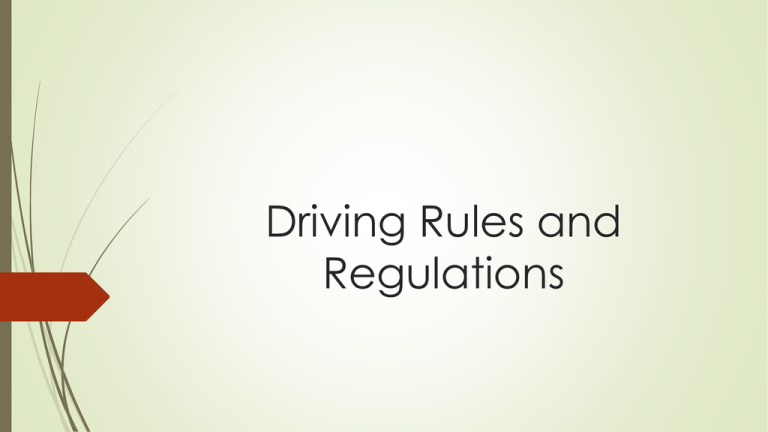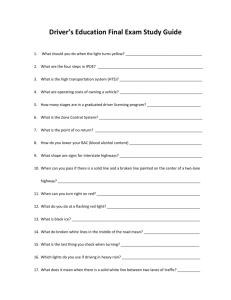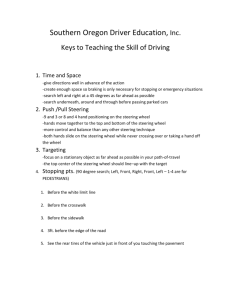Driving Rules and Regulations PPT
advertisement

Driving Rules and Regulations Do Now… Write one question you have in regards to how to drive a car. This will be collected and answered throughout the final unit. Car Condition It is the responsibility of the vehicle owner to ensure proper working condition of their vehicle. The following items should always be checked before driving: Back Up Lights Brakes Brake Lights Headlights Horn Steering Tail Lights Tires Turn Signals Windshield Snow and Ice Starting a Parked Car You should look Behind and In Front of your vehicle before getting in. Three things you should be looking for: Debris (example: bottles, cans, etc.) Bicycles Children playing Starting a Parked Car What needs to be in order before you start your car? All windows should be clean Seat needs to be adjusted so the motorist can reach all the pedals and the controls. Inside and outside rearview mirrors should be adjusted. Seatbelts and shoulder harnesses should be fastened so they are firm and comfortable. The vehicle should be in park (or neutral) and the parking brake set. Doors should be locked Starting a Parked Car The seat is properly positioned in the vehicle if the driver can easily reach the foot pedals, turn signals, gear shift levers, and dashboard controls. More than 95% of the information drivers needs when driving is visual so if glasses or contacts are needed for driving they should be worn at all times. Drivers should get their eyes checked every 2 years. After starting the vehicle, the driver should turn their head and look back to see if their path is clear rather than relying on the mirror. The mirrors inside and outside the car should be adjusted to properly reduce blind spots. Starting a Parked Car Blind Spot – an area where a motorist cannot see behind his/her vehicle (on both sides) through the mirror. Steering If you think of the steering wheel as a clock when gripping the wheel you should hold it at: Left Hand – 9 Right Hand – 3 Holding the wheel in this position diminished the risk of hand, wrist or arm injury. Steering A driver should grip the wheel firm but not too tight. Both hands should be on the wheel at all times unless the driver is shifting gears or giving hand signals. Hand over hand steering helps a driver make steering adjustments ranging from very minor up to a half turn of the wheel, while keeping both hands on the wheel. Driving Signals Drivers should ALWAYS signal when: Turning Changing Lanes Stopping or slowing down A driver should turn on their signal 100 feet before turning. Making sure the turn signal is off after the turn is important because it could mislead other drivers. The horn is a signal that could be used to warn and communicate with other drivers. Hand Signals In the case your turn signals are not working, you should use Hand Signals. Stop or Slowing Down – Hand and arm downward Right Turn – Hand and arm upward Left Turn – Hand and arm straight out Driving in Reverse When driving in reverse, make sure your path is clear. Turn the wheel to the right – the back of the car will go right Turn the wheel to the left – the back of the car will go left Not turning the wheel will allow the car to go straight backwards Your head and body should be turned to the right until driver can clearly see through the back window without using the mirrors. Driving in Reverse When reversing in a straight line: The driver’s right hand and arm should be placed on the back of the front passenger seat. The left hand should be holding the top of the steering wheel. When reversing and needing to turn the wheel (Ex: Parallel Parking): Two hands must be on the wheel while the driver’s head and body are turned to look out the rear window. When turning in reverse, the front of the vehicle is going to go the opposite direction as the back of the car. Turning The faster the traffic is moving, the sooner the driver should plan their turn. Before turning a driver should always: Use the mirrors to look behind and at sides. Check for less visible vehicles Signal first, move into the proper lane Slow down Keep a steady speed and follow pavement markings Stay in the same lane until the turn is finished Turn the turn signal off once the turn is complete Executing a Right Turn Approach as far Right as possible Do not swing outward or into another lane Turn on the right turn signal Check Right for Pedestrians, Left for Traffic Executing a Left Turn Turn the left turn signal on Check Left-Right-Left Do not cross lane markings (begin near center of road) Turn into the lane nearest the center of the road. Executing a Left Turn Left Turn from a 2-way road onto a 2-way road: Approach the turn as close as possible to the line nearest to the center of the road. When turning, the vehicle should not cross lane markings. The motorist should keep to the right of the center line of the road the vehicle is entering. Executing a Left Turn Left turn from a two-way road onto a four lane highway: Approach the turn as close to the center line of the right side of the road as possible. Make the turn before reaching the center line of the intersection It is important not to cross lane markings. The motorist should turn into the lane nearest the center line of the right side of the other road. This is the passing lane of the four lane highway. When traffic permits, the motorist should move to the right, out of the passing lane. How to make a left turn Do Now…. Name 3 things you are looking for when checking around the vehicle. What is a blind spot? When steering your left hand should be placed at ________. When steering your right hand should be placed at ________. What are the 2 ways to signal a turn? How far in advance must a motorist use a proper turn signal? Stopping Regulations Four situations when you must stop: An intersection with a stop sign A Red light When an officer orders you to stop When you come to a yield sign when there is oncoming traffic Railroad Crossings A vehicle must stop 15 feet from a railroad crossing when the lights are flashing, gates are coming down, and bells are ringing. School Buses When the flashing lights are on as a vehicle approaches a school bus you must: Stop at least 25 feet away on a 2-way road, either side Slow down to 10 mph if on the other side of a road that is divided by a median. Parking Regulations Five places you CANNOT park are: On a crosswalk On a sidewalk Bus stop zone Fire zone/Fire Hydrant In an intersection Parking Regulations You must be at least: 10 feet from a fire hydrant 25 feet from a crosswalk 50 feet from a stop sign 20 feet from a fire station (same side) 75 feet from the curb opposite a fire station Road Conditions When driving through a water puddle, a motorist should test the brakes by pumping them. Hydroplane – when tires ride up on a film of water, which could cause a motorist to lose control of the vehicle. In a heavy rainstorm, try to drive on the highest point of the road. (center part of the road) Uncontrolled Intersections – there are no traffic lights are road signs. Sun visors should always be adjusted to shield a motorist’s eyes without cutting off the view of the road. During foggy conditions, headlights should be kept on low beam. At night a motorists vision is reduced. Nearly 90% of driving decisions are based upon what a motorist sees while driving. Exceeding the speed limit or driving too fast for road conditions is one of the most prevalent factors contributing to traffic collisions. In NJ traffic fines are doubled for motor vehicle violations committed in the area of roadway construction zones. Road Conditions - Winter Winter driving has special dangers, including longer hours of darkness, fog, rain, snow, sleet and ice. A vehicle will skid on ice if a motorist accelerates too quickly. When stuck in snow or ice, rock the vehicle back and forth by shifting between forward and reverse to escape. Tire chains help driving during the winter months by providing better traction. These may be used from November 15th – April 1st. All snow and ice must be removed from the entire vehicle before you begin to drive. It’s a law! NJ law states that the motorist is responsible for any ice that flies from their vehicle that causes damage, injury, or death. Emergency Situations Reacting properly during an emergency can avoid collisions and minimize damage. When the vehicle is skidding turn the vehicle to the rear. Avoid using the brakes during a side skid. To control the vehicle during a tire blowout, a motorist should the steering wheel firmly and remove the foot from the gas pedal. If a collision looks possible motorist should always turn away from oncoming traffic. A driver should always signal when pulling off the road in an emergency. During the day or night, when pulled over to the side of the road for an emergency place a flare behind the vehicle to warn other drivers. When a vehicle plunges into water, the first thing to do is open the window. What should be the first thing done after a collision?






